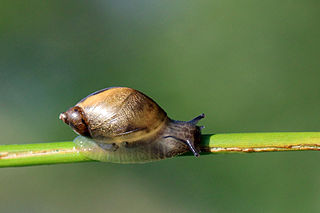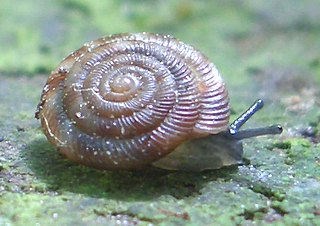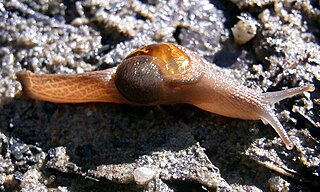
Succinea, common name the amber snails, is a large genus of small, air-breathing land snails, terrestrial pulmonate gastropod molluscs in the family Succineidae.

Zonitidae, common name the true glass snails, are a family of mostly rather small, air-breathing land snails, terrestrial pulmonate gastropod mollusks in the superfamily Zonitoidea.

Suboestophora hispanica is a species of small air-breathing land snail, a terrestrial pulmonate gastropod mollusk in the family Trissexodontidae within the Helicoidea.

Helicarionidae is a family of air-breathing land snails or semi-slugs, terrestrial pulmonate gastropod mollusks in the superfamily Helicarionoidea.

Diplommatinidae is a family of small land snails, also known as staircase snails, with an operculum, terrestrial gastropod mollusks in the superfamily Cyclophoroidea. The Cochlostomatinae Kobelt, 1902, were previously considered a subfamily of the Diplommatinidae, but are now known to be a separate family.

Euconulidae is a taxonomic family of minute, air-breathing land snails, terrestrial pulmonate gastropod mollusks or micromollusks in the superfamily Trochomorphoidea.

Discus rotundatus, common name rotund disc, is a species of small, air-breathing, land snail, a terrestrial pulmonate gastropod mollusk in the family Discidae, the disk snails.

Punctum pygmaeum is a species of very small, air-breathing land snail, a terrestrial pulmonate gastropod mollusk in the family Punctidae, the dot snails.

Canariella hispidula is a species of small, air-breathing land snails, terrestrial pulmonate gastropod mollusks in the family Canariellidae, the hairy snails and their allies.

Macrochlamys is a large genus of air-breathing land snails, terrestrial pulmonate gastropod mollusks in the family Ariophantidae.
Succinea costaricana is a species of air-breathing land snail, a terrestrial pulmonate gastropod mollusc in the family Succineidae, the amber snails. The individuals can reach up to 13.5 mm long. When reproducing, females can lay 7 eggs per cluster; each egg measuring 1.4 mm diameter. Embryos measure approximately 0.3 mm, while its shell can reach around 0.8 mm in length. The animals can reproduce at 12 weeks of age and their lifespan is approximately 44 weeks.

Zachrysia provisoria, commonly known as the Cuban Brown Snail is a species of air-breathing land snail, terrestrial pulmonate gastropod mollusk in the family Camaenidae or Pleurodontidae.

Beckianum beckianum is a species of air-breathing land snail, a terrestrial pulmonate gastropod mollusc in the family Achatinidae.

Pittieria aurantiaca is a species of predatory air-breathing land snail, a terrestrial pulmonate gastropod mollusk in the family Spiraxidae.

Helicarion mastersi is a species of air-breathing land snail, also referred to as a semi-slug because of its small shell. It is a terrestrial pulmonate gastropod mollusc in the family Helicarionidae.

Clanculus euchelioides, common name the small top shell, is a species of sea snail, a marine gastropod mollusk in the family Trochidae, the top snails.

Gudeodiscus messageri is a species of air-breathing land snail, a terrestrial pulmonate gastropod mollusk in the family Plectopylidae.
Raphitoma alida is an extinct species of sea snail, a marine gastropod mollusc in the family Raphitomidae.

Drymaeus tripictus is a species of air-breathing land snail, a terrestrial pulmonate gastropod mollusc in the family Bulimulidae.




















